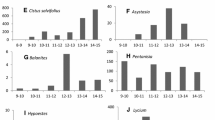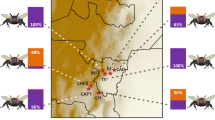Summary
The orchid Prasophyllum fimbria is pollinated by nectar-feeding native bees and wasps. The pollinia are patially separated from the viscidium by a stipe so that pollinia can be labelled with coloured histochemical stains without interfering with pollinarium removal. Pollen flow was monitored by following the movement of the coloured pollen in several populations of P. fimbria in Western Australia. Statistical analysis confirmed that pollen labelling did not interfere with pollinarium removal or subsequent pollination of the labelled flower. Fifty eight labelled pollinaria were removed by vectors from 16 test spikes, with a total of 125 flowers on 47 spikes receiving labelled pollen. An average of 2 flowers received pollen for every pollinium removed but up to 6 flowers received pollen from a single collinium. No significant differences between mean vector flights and pollen flow distances were detected. On average, geitonogamous transfers only accounted for 22% of all pollinations. This is a simple and inexpensive technique for the direct labelling of pollen with minimal disruption to the pollination system and may have applications in other plant families.
Similar content being viewed by others
References
Campbell DR (1985) Pollen and gene dispersal: The influences of competition for pollination. Evol 39:418–431
Colwell RN (1951) The use of radioactive isotopes in determining spore distribution patterns. Am J Bot 38:511–523
Handel SN (1976) Restricted pollen flow of two woodland herbs determined by neutron-activation analysis. Nature 260:422–423
Handel SN (1982) Dynamics of gene flow in an experimental garden of Cucumis melo (Cucurbitaceae). Am J Bot 69:1538–1546
Handel SN (1983a) Pollination ecology, plant population structure, and gene flow. In Real L (ed) Pollination Biology, Academic Press, New York, pp 163–211
Handel SN (1983b) Contrasting gene flow patterns and genetic subdivision in adjacent populations of Cucumis sativus (Cucurbitaceae). Evol 37:760–771
Levin DA (1981) Dispersal versus gene flow in plants. Ann Missouri Bot Gard 68:233–253
Levin DA, Kerster HW (1974) Gene flow in seed plants. Evol Biol 7:139–220
Linhart YB (1973) Ecological and behavioural determinants of pollen dispersal in hummingbird pollinated Heliconia. Am Nat 197:511–523
Linhart YB, Feinsinger P (1980) Plant-hummingbird interactions: Effects of island size and degree of specialization on pollination. J Ecol 68:745–760
Murawski DA, Gilbert LE (1986) Pollen flow in Psiguria warscewiczii a comparison of Heliconius butterflies and hummingbirds. Oecologia 68:161–168
Peakall R (1987) Genetic Systems of Australian Terrestrial Orchids. Ph D thesis University of Western Australia.
Price MV, Waser NM (1982) Experimental studies of pollen carryover: Hummingbirds and Ipomopsis aggregata. Oceologia 54:353–358
Richards AJ, Ibrahim H (1978) Estimation of neighbourhood size in two populations of Primula veris. In Richards AJ (Ed) The Pollination of Flowers by Insects. Academic Press, London pp 165–174
Schlising RA, Turpin RA (1971) Hummingbird dispersal of Delphinium cardinale pollen treated with radioactive iodine. Amer J Bot 58:401–406
Schmitt J (1980) Pollinator foraging behaviour and gene dispersal in Senecio (Compositae). Evol 34:934–943
Thomson JD (1986) Pollen transport and deposition by bumble bees in Erythronium influences of floral nectar and bee grooming. J Ecol 74:329–341
Thomson JD, Plowright RC (1980) Pollen carry over, nectar rewards, and pollinator behaviour with special reference to Diervilla lonicera. Oceologia 46:68–74
Thomson JD, Price MV, Waser NM, Stratton DA (1986) Comparative studies of pollen and fluorescent dye transport by bumble bees visiting Erythronium grandiflorum. Oecologia 69:561–566
Waser NM (1988) Comparative pollen and dye transfer by pollinators of Delphinium nelsonii. Functional Ecology 2:41–48
Waser NM, Price MV (1982) A comparison of pollen and fluorescent dye carryover by natural pollinators of Ipomopsis aggregata (Polemoniaceae). Ecology 63:1168–1172
Waser NM, Price MV (1983) Optimal and actual outcrossing in plants, and the nature of plant pollinator interaction. In Jones CE, Little RJ (Eds) Handbook of Experimental Pollination Biology. Scientific & Academic, New York pp 341–359
Webb CJ, Bawa KS (1983) Pollen dispersal by hummingbirds and butterflies: A comparative study of two lowland tropical plants. Evol 37:258–1270
Author information
Authors and Affiliations
Rights and permissions
About this article
Cite this article
Peakall, R. A new technique for monitoring pollen flow in orchids. Oecologia 79, 361–365 (1989). https://doi.org/10.1007/BF00384315
Received:
Published:
Issue Date:
DOI: https://doi.org/10.1007/BF00384315




